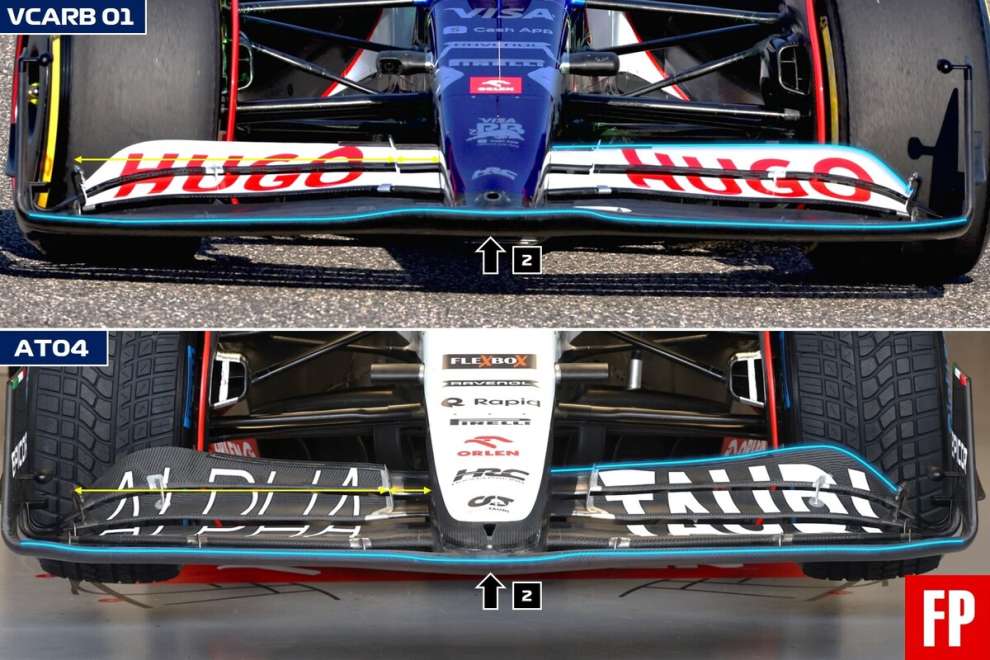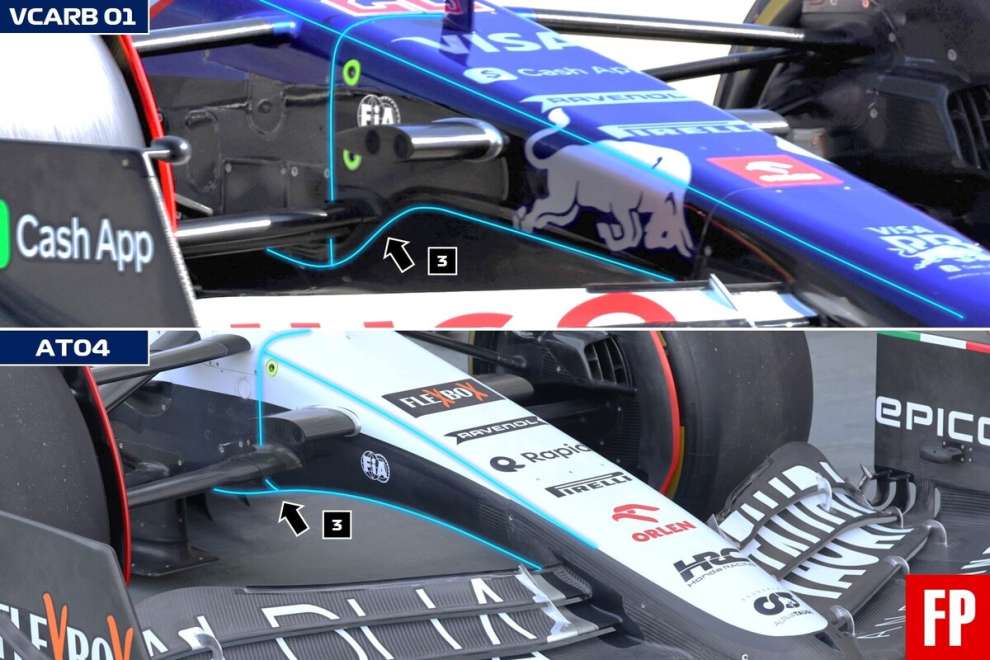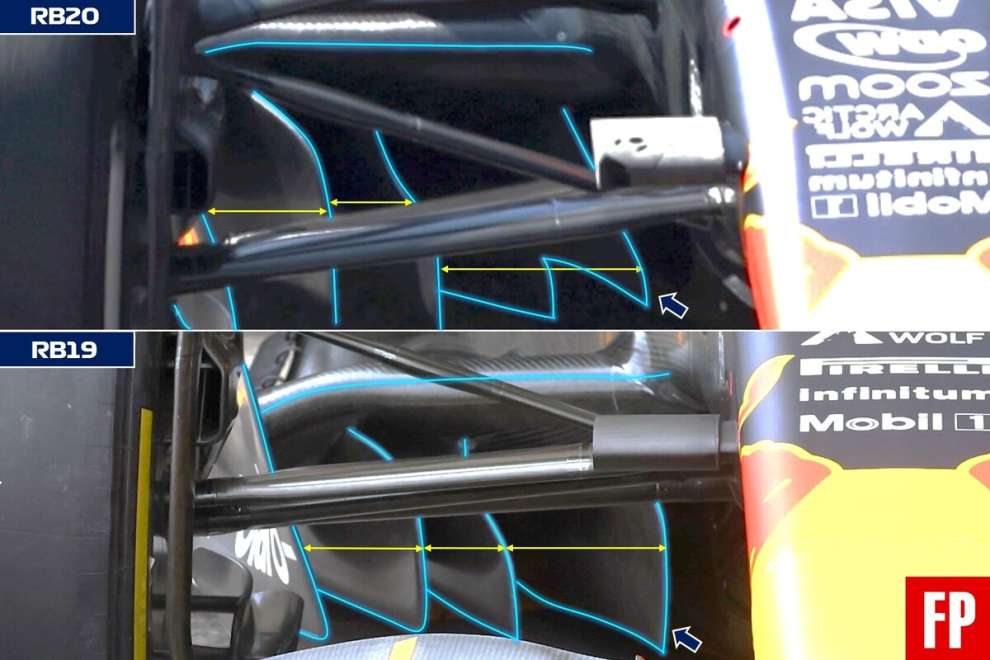By Carlo Platella
With the VCARB-01, Racing Bulls materializes the revolution undertaken in 2023. Faced with the difficulty of improving performance, last summer the Faenza team decided to take a step back, rethinking the basic concept. As announced by the group's top management, the new single-seater strengthens the bond with the parent company Red Bull, both from the point of view of aerodynamic solutions and shared components. The VCARB-01, however, it does not represent a simple copy of the RB19, of which he collects the legacy, reinterpreting it in his own way.
Common roads
Racing Bulls' strategy to take up the concepts of world champion Red Bull is justified by a twofold reason. In addition to the undisputed effectiveness of the aerodynamic shapes of the RB19, the Faenza team shares the Honda-Red Bull Powertrain power unit with the parent company, as well as the suspension mechanics. As in the case of Ferrari and Haas, similar architectures bring with them the same constraints and opportunities.
Prominent news on the VCARB-01 is the purchase of the Red Bull front suspension, thus passing from push-rod to pull-rod scheme. The internal spring-shock absorber group is moved to the lower part of the frame, redesigned accordingly. Between the pull rod and push rod mechanisms there is no general superiority of one over the other, but their quality depends on the way in which they are implemented and above all integrated with the rest of the car.
More than the pull rod itself, it was important for AlphaTauri to be able to count on the front suspension which contributed so much to the effectiveness of the latest ground effect Red Bulls, not only for the distribution of the flows coming from the front. In fact, never more than with the current regulations, mechanics are fundamental to aerodynamic performancestabilizing the surface at constant angles and heights from the ground during the various movements experienced while driving.
Suspensions
The front view perfectly highlights the inversion of the front suspension rod, which decrees the transition to the tie rod scheme. For the rest, the box and the steering arm remain aligned with the lower triangle, while the arrangement of the upper elements changes, a novelty which in any case is not surprising. In fact, like Racing Bulls, all the teams on the grid have the front and rear arms staggered in height (1), implementing the anti-pitching kinematicsuseful for stabilizing the posture of the bottom during braking.
The rear suspension of the VCARB-01, however, does not present anything revolutionary, at least as far as it can be appreciated from the outside. In fact, the Faenza team, together with McLaren, Red Bull and Sauber was among the first to introduce the rear push-rod from 2022first year of ground effect regulations, choice also confirmed for 2024.

Front end
The front wing is different in the performance of the main profile, which now rises in the center (2), favoring the channeling of flows under the car body and reducing its aerodynamic sensitivity to heights from the ground. The nose continues to extend up to the first element, but appears slimmed down compared to the end-2023 specification. For the rest, the wing has no other macroscopic differences compared to the previous AT04, with an almost identical distribution between the fixed and adjustable sections of the upper flaps.

In the rearmost part of the muzzle, or rather of the front impact structure, important innovations can be seen. The connection with the frame presents a greater discontinuity (3), necessary to accommodate the new Red Bull front suspension, with a non-negligible impact on the local flow management.

Bottom
The Venturi channels are the great area where the difference is made in the ground effect era and it is here that some differences emerge between Racing Bulls and the parent company Red Bull. On the VCARB-01 the team has the roof of the entrance section was redesigned, remaining high up to the outermost end, where it was going to drop in 2023 (4). The distribution of the lateral distances between the flow conveyors (5) also changes slightly, more irregular than that seen on the Red Bull, however a sign of a different flow field under the car.


The outermost bulkhead of the bottom remains similar in concept to that of the end of 2023, with greater folding in the lower part. There are also minimal changes to the fairing of the side impact structure. Moving to the outer edge of the surface, an area of great development on all single-seaters, Racing Bulls continues on the direction taken in 2023. Following the dominant geometry in the grid, the most advanced rise (6) is still present, followed by the rear knife profile. However, the double cascade of front profiles introduced by Red Bull in 2023 and already taken up by some teams, including Williams, is absent.


Car body
On the VCARB-01 the side vents change, widened and flattened upwards (7), inspired by the mouths of the Red Bull 2023 and now taken up by almost all the competitors, from which the world champions have also already distanced themselves with the RB20. From the side you can also appreciate the forward extension of the lower lip of the mouth (8), a geometry now almost omnipresent in the grille to better channel the flows under the side and pressurize the environment on the sides of the passenger compartment.


In terms of bodywork, the Faenza team continues with the flat-bellied approach, refined in various points. In the upper part, the triangular invitation present until 2023 (9) disappears, also removed on the 2024 Red Bull. In the lower area however, it is leveled the bulge present on the AT04 at the end of 2023 (10), reducing energy losses in the flows conveyed to the diffuser environment. The change is indicative of a major redistribution of internal components, radiators and electronics above all. Finally, the aerial view confirms the presence of the slides dug into the sides, which are almost absent on both the RB19 and the RB20.


Much more than a Red Bull
The Faenza team strengthens the technical collaboration with the parent company, making the most of the opportunities of the regulationor to purchase transferable components from Red Bull, especially suspension and transmission, an opportunity also taken up by Haas. Precisely the poor performances of the Italian-American team underline how the purchase of components from a top team is not a guarantee of success, but must be enhanced by a valid aerodynamic structure
Racing Bulls for its part, had already been in the second half of last season protagonist of a remarkable recovery, establishing itself as the sixth effective force on the pitch at the close of the championship. A reconfirmation of him in the upper-central part of the grid would therefore not cause surprise and above all it would not be attributable solely to the strengthening of the partnership with Red Bull. Surely, however, being able to count on the updated mechanics of the world champions will be a very useful tool for the campaign of the Faenza team.
#technical #analysis #Racing #Bulls #addition #Red #Bull